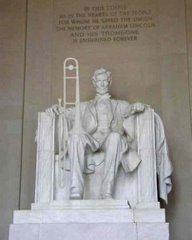Whatever happened to David Huddleston, star of The Kallikaks? How many quarterbacks (e.g.,
And when was the last time you saw neon letters announcing, “In Concert Tonight: Ronnie Montrose!”?
Apparently, author George Pendle never considered such questions. Or, if he did, he didn’t bother to explore them in his new book on the great Millard Fillmore. What’s even more remarkable about Pendle’s omissions is that he notes in his preface that 1) Fillmore’s manuscripts were written in ballpoint pen and 2) ballpoint pens were invented more than half a century after the man’s death. He attributes this supposed inconsistency to the president being ahead of his time rather than delving into the explanation more consistent with known Internet accounts; of course, I’m referring to time travel.
Now obviously I’m not suggesting that our 13th president could trek through time. That would be asinine. A far more plausible explanation is that post-mid 20th century minor celebrities found a tear in the space-time continuum that led them to the 1850s. Those who dared journey (Huddleston, Komlo, Montrose, and so many others) soon found themselves in the presence of Fillmore which, by all accounts save Pendle’s, is a rather intimidating place to be. Let’s just say that the spells of their “celebrity”, not to mention several of their facial bones, were soon broken.
And that’s another thing. Pendle portrays Fillmore as a dense, naïve, and delicately sensitive fruit basket of a man. Time-travelers, of course, tell a different tale. They speak of a coarse and terrifying individual who would use his lateral incisors to rip the faces off his enemies, or even his subordinates if he needed to get someone’s attention (Note: He killed some of today’s celebrities in this very manner, although they do not make the trip to the 1850s until after this review is published).
The representation of Fillmore as some sort of 19th century Barney/Colonel Klink hybrid (and, by the way, what do you suppose ever happened to them?) is particularly odd given that Pendle provides us with a detailed and spot-on characterization of wife Abigail. Correctly, she is noted to be intelligent, insightful, and relatively funny in a Carol Leifer sort of way. But the author stops short of explaining why such a woman would marry a dullard like the Fillmore he depicts. The implication, I suppose, is that Abigail was roughly as desirable as a pack mule, but my guess is Pendle knows better. After all, his very first day of research would have surely uncovered the famous quote by Zachary Taylor (whom Fillmore succeeded into the presidency):
“Members of the cabinet, I congratulate you upon the high state of prosperity to which the goodness of Divine Providence has conducted our common country. Let us invoke a continuance of the same protecting care which has led us from small beginnings to the eminence we this day occupy. By the way, before Fillmore gets back from his squat, did anyone happen to see Abigail in that new Victorian number? I swear to God, her ass never quits!”
There are other instances too in which Pendle displays remarkable research skills, then fails to deliver the entire story. He describes, for example, the Anti-Masons’ hidden chamber in the
All in all, I would have to say that Pendle employs an interesting take on some elements of the Fillmores’ life. Had he simply followed his investigative leads, however, his account could have been so much more.

8 comments:
fillmore sucks
I thought the book was simply splendid, the finest example of humor writing since “The Magic Johnson Show!”
Damn the Masons and their secret handshakes and bloody "I'm better than a Vicar's tit" attitude! A cup of tea and a sardine on crumpet is spot on, I say, good man, for a brilliantly written piece on one of the Colony's finest Gentlemen. It's told to my, by way of the great Winston's Churchill's chimney sweeps cousins barber, that Lord Fillmore visited the Queen Mother on more than one occasion in private. Propriety and gentleness prevent me from revealing the details of the tryst, but I will say it involved foot care and vinegar.
Ho HO! Footcare AND vinegar? Sounds like someone owned a Bruce the Male Nurse costume!
Among world-class athletes, I have the biggest set of maguppies since Nancy Lopez!
Thank you for the very fair review. I added it to my self-improvement portfolio.
Your blog keeps getting better and better! Your older articles are not as good as newer ones you have a lot more creativity and originality now keep it up!
Genial post and this enter helped me alot in my college assignement. Thanks you on your information.
Post a Comment